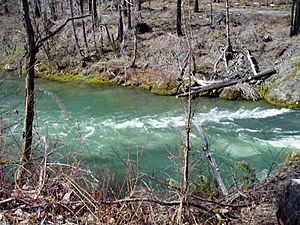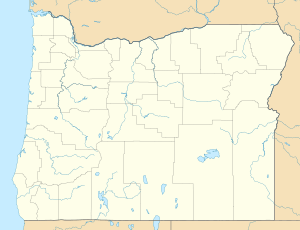Fall Creek (Middle Fork Willamette River tributary) facts for kids
Quick facts for kids Fall Creek |
|
|---|---|

Fall Creek in the Cascade Range foothills
|
|
|
Location of the mouth of Fall Creek in Oregon
|
|
| Country | United States |
| State | Oregon |
| County | Lane |
| Physical characteristics | |
| Main source | Cascade Range near Sardine Butte, Willamette National Forest 3,782 ft (1,153 m) 43°59′22″N 122°19′21″W / 43.98944°N 122.32250°W |
| River mouth | Middle Fork Willamette River near Jasper 561 ft (171 m) 43°58′14″N 122°52′10″W / 43.97056°N 122.86944°W |
| Length | 34 mi (55 km) |
Fall Creek is a beautiful stream in Oregon, USA. It's about 34 miles (55 km) long. This creek flows into the Middle Fork Willamette River.
Fall Creek starts high up in the Cascade Range mountains. It then flows west through the Willamette National Forest. Finally, it joins the Middle Fork near a town called Jasper. This area is southeast of bigger cities like Springfield and Eugene.
Along its path, Fall Creek passes many fun places. You can find campgrounds, picnic spots, and a state park. There's also a special hiking trail called the Fall Creek National Recreation Trail. A large man-made lake, Fall Creek Reservoir, is formed by the Fall Creek Dam. Below the dam, small towns like Unity and Fall Creek are located. Two old covered bridges cross the creek, adding to its charm.
Contents
Crossing Fall Creek: Covered Bridges
Fall Creek is known for its historic covered bridges. These bridges are like tunnels for cars, protecting the wooden structure inside from weather.
Unity Bridge
The Unity Bridge is near the town of Unity. It carries the Unity–Lowell Road over Fall Creek. This bridge is about 1 mile (1.6 km) below the Fall Creek Reservoir. It's also about 6 miles (9.7 km) from where the creek joins the Middle Fork Willamette River. The Unity Bridge was added to the National Register of Historic Places in 1979. This means it's an important historical landmark.
Pengra Bridge
Further downstream, you'll find the Pengra Bridge. This bridge carries Place Road over the creek. It's a 120-foot (37 m) long bridge built in 1938. It uses a special design called a Howe truss. Like the Unity Bridge, the Pengra Bridge was also added to the National Register of Historic Places in 1979.
Fun Things to Do at Fall Creek
Fall Creek is a popular spot for outdoor activities. Many people visit to hike, camp, and fish.
Hiking and Camping Adventures
The Fall Creek National Recreation Trail is a great place to explore. It stretches for 13.7 miles (22 km) along the creek. You can access the trail from five different spots. It's mostly flat, making it easy for many hikers. Small footbridges help you cross side streams. This trail also connects to other trails, like Clark Butte and Gold Point.
There are several campgrounds along the Fall Creek National Recreation Trail. Some popular ones include Dolly Varden, Big Pool, and Broken Bowl. The Clark Creek Organization Camp was built in the 1930s. It's a special camp designed for groups.
Fall Creek State Park
The Fall Creek State Recreation Site is a state park located at Fall Creek Reservoir. This park has many different areas for camping and day visits. Each area offers different things like boat launches, swimming spots, and picnic tables. You'll also find restrooms and parking. The park covers 167 acres (68 ha) and is open from May through September.
Fishing for Trout and Salmon
Fall Creek is a favorite place for fishing. People often call it a "beautiful" creek. Anglers (people who fish) come here to catch different types of fish.
- Chinook salmon (Oncorhynchus tshawytscha): These are hatchery fish, meaning they were raised in a special facility.
- Rainbow trout (Oncorhynchus mykiss): These fish are also stocked in the creek.
- Cutthroat trout (Oncorhynchus clarkii): These are wild fish that live naturally in the creek.
For a while, it was hard for young salmon to swim out of the reservoir. This was because of other fish like largemouth bass and crappie. These fish are not native to the area and would eat the young salmon.
A smart idea in 2019 helped solve this problem. For a short time each year, the reservoir was drained almost completely. This helped the salmon swim out more easily. It also flushed out the non-native fish, which couldn't survive in the colder river water. This simple plan has helped more salmon leave the reservoir. It has also reduced the number of invasive fish like largemouth bass and crappie.
Above Fall Creek Lake, the creek is regularly stocked with rainbow trout. Below the dam, you can find salmon, steelhead (which are rainbow trout that go to the ocean), and other salmon.


